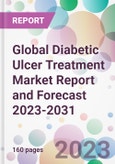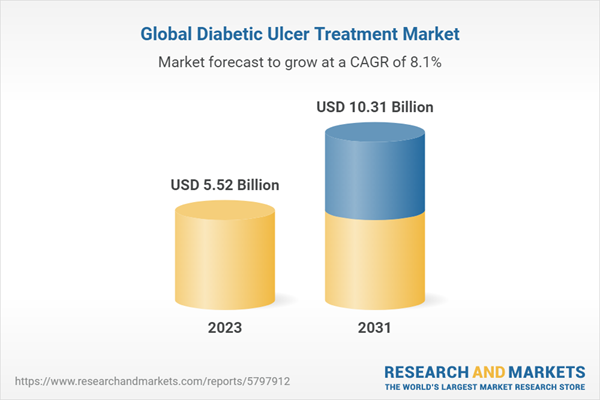The global diabetic ulcer treatment market value was USD 5.1 billion in 2022, driven by the increasing prevalence of diabetes across the globe. The market size is anticipated to grow at a CAGR of 8.1% during the forecast period of 2023-2031 to achieve a value of USD 10.3 billion by 2031.
The market for diabetic ulcer treatment is driven by the growing prevalence of diabetes and the increasing number of diabetic patients with foot ulcers. The global diabetic ulcer treatment market is expected to grow at a CAGR of 6.5% during the forecast period of 2021-2028.
Factors driving the growth of the market include the increasing prevalence of diabetes, the growing geriatric population, and rising awareness about diabetic foot care. Additionally, technological advancements in wound care products and the increasing availability of effective treatment options are also contributing to market growth.
However, high treatment costs and the lack of awareness about diabetic ulcer treatment in developing countries may restrain market growth to some extent. Overall, the diabetic ulcer treatment market is expected to experience significant growth in the coming years, driven by a combination of demographic, economic, and technological factors.
Diabetic Ulcer Treatment Introduction
Diabetic ulcer refers to an open sore that occurs on the foot of individuals with diabetes. Diabetic ulcer treatment is critical to avoid serious complications such as infection and gangrene that can result in amputation. The market for diabetic ulcer treatment includes various products such as dressings, wound care devices, and advanced therapies. The increasing prevalence of diabetes and the growing geriatric population are key drivers for the growth of this market. Moreover, the rise in awareness regarding the management of diabetic ulcers and the availability of advanced wound care products are also contributing to market growth. Technological advancements in the development of advanced wound care products are expected to further boost the market growth. However, the high cost of advanced wound care products and the lack of awareness in underdeveloped economies may hinder the market growth.Diabetic Ulcer Treatment Market Scenario
Diabetic ulcers are a common complication of diabetes that affects the feet and legs of diabetic patients. These ulcers are caused by damage to the nerves and blood vessels, which can lead to poor circulation and reduced sensation in the affected area. Treatment for diabetic ulcers typically involves wound care, medication, and lifestyle changes to prevent further damage.The market for diabetic ulcer treatment is driven by the growing prevalence of diabetes and the increasing number of diabetic patients with foot ulcers. The global diabetic ulcer treatment market is expected to grow at a CAGR of 6.5% during the forecast period of 2021-2028.
Factors driving the growth of the market include the increasing prevalence of diabetes, the growing geriatric population, and rising awareness about diabetic foot care. Additionally, technological advancements in wound care products and the increasing availability of effective treatment options are also contributing to market growth.
However, high treatment costs and the lack of awareness about diabetic ulcer treatment in developing countries may restrain market growth to some extent. Overall, the diabetic ulcer treatment market is expected to experience significant growth in the coming years, driven by a combination of demographic, economic, and technological factors.
Diabetic Ulcer Treatment Market Segmentations
Market Breakup by Treatment Type
Wound Care Dressing
- Antimicrobial Dressings
- Film Dressings
- Alginate Dressings
- Others
Wound care Devices
- Negative Pressure Wound Therapy
- Hyperbaric Oxygen Therapy
- Ultrasound Therapy
- Others
Active Therapies
- Skin Grafts and Substitutes
- Growth Factors
- Hemostatic Agents and Sealants
- Other
Market Breakup by Grade
- Grade 1
- Grade 2
- Grade 3
- Grade 4
- Grade 5
Market Breakup by Ulcer Types
- Neuropathic Ulcers
- Ischemic Ulcers
- Neuro-Ischemic Ulcers
- Others
Market Breakup by End User
- Hospital Inpatient Settings
- Hospital Outpatient Settings
- Community Health Centers
- Home Healthcare
- Others
Market Breakup by Region
North America
- United States of America
- Canada
Europe
- United Kingdom
- Germany
- France
- Italy
- Others
Asia Pacific
- China
- Japan
- India
- ASEAN
- Australia
- Others
Latin America
- Brazil
- Argentina
- Mexico
- Others
Middle East and Africa
- Saudi Arabia
- United Arab Emirates
- Nigeria
- South Africa
- Others
Key Trends in the Diabetic Ulcer Treatment Market
- Rising prevalence of diabetes: With the growing number of people with diabetes, the prevalence of diabetic ulcers is also increasing, creating a significant demand for diabetic ulcer treatment
- Increasing focus on early intervention: Early intervention and treatment of diabetic ulcers can prevent more serious complications, leading to a greater focus on early detection and treatment
- Technological advancements: Advances in technology, including the development of new wound care products and therapies, are driving innovation in the diabetic ulcer treatment market
- Growing demand for combination therapies: The use of combination therapies, including dressings and topical agents, is becoming more popular for the treatment of diabetic ulcers. This is expected to drive growth in the market for these products
- Increased focus on prevention: As the importance of prevention in managing diabetes becomes more apparent, there is a growing focus on prevention strategies to reduce the incidence of diabetic ulcers
Diabetic Ulcer Treatment Market: Competitor Landscape
The key features of the market report include patent analysis, grants analysis, clinical trials analysis, funding and investment analysis, partnerships, and collaborations analysis by the leading key players. The major companies in the market are as follows:- ConvaTec Group plc
- Acelity L.P. Inc
- 3M Company
- Smith and Nephew Plc
- B. Braun Melsungen Ag
- Medline Industries, LP
- Medtronic Plc
- Organogenesis Holdings Inc
- Molnlycke Health Care AB
- BSN Medical GMBH
- Integra LifeSciences Corporation
- Tissue Regenix
- Coloplast Corp
- Cardinal Health
- 3M
Table of Contents
1 Preface
3 Diabetic Ulcer Overview
4 Patient Profile
5 Diabetic Ulcer Epidemiology Analysis
6 Global Diabetic Ulcer Treatment Market Overview
7 Global Diabetic Ulcer Treatment Market Landscape
8 Diabetic Ulcer Treatment Challenges and Unmet Needs
10 Global Diabetic Ulcer Treatment Market Dynamics
11 Global Diabetic Ulcer Treatment Market Segmentation
12 North America Diabetic Ulcer Treatment Market
13 Europe Diabetic Ulcer Treatment Market
14 Asia Pacific Diabetic Ulcer Treatment Market
15 Latin America Diabetic Ulcer Treatment Market
16 Middle East and Africa Diabetic Ulcer Treatment Market
17 Regulatory Framework
18 Patent Analysis
19 Grants Analysis
20 Clinical Trials Analysis
21 Funding and Investment Analysis
22 Partnership and Collaborations Analysis
23 Supplier Landscape
24 Diabetic Ulcer Treatment - Distribution Model (Additional Insight)
26 Company Competitiveness Analysis (Additional Insight)
27 Payment Methods (Additional Insight)
Companies Mentioned
- Convatec Group plc
- Acelity L.P. Inc.
- 3M Company
- Smith and Nephew plc.
- B. Braun Melsungen AG
- Medline Industries, Lp
- Medtronic plc
- Organogenesis Holdings Inc
- Molnlycke Health Care Ab
- Bsn Medical GmbH
- Integra Lifesciences Corporation
- Tissue Regenix
- Coloplast Corp
- Cardinal Health.
- 3M
Methodology

LOADING...
Table Information
| Report Attribute | Details |
|---|---|
| No. of Pages | 160 |
| Published | May 2023 |
| Forecast Period | 2023 - 2031 |
| Estimated Market Value ( USD | $ 5.52 Billion |
| Forecasted Market Value ( USD | $ 10.31 Billion |
| Compound Annual Growth Rate | 8.1% |
| Regions Covered | Global |
| No. of Companies Mentioned | 15 |









